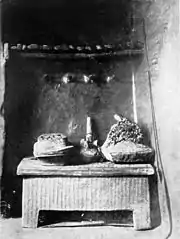Ogbanje
An ọgbanje is a term in Odinani (Igbo: ọ̀dị̀nànị̀) for what was believed to be an evil spirit that would deliberately plague a family with misfortune. Its literal translation in the Igbo language is "children who come and go". It was believed that within a certain amount of time from birth (usually not past puberty), the ọgbanje would deliberately die and then come back and repeat the cycle causing the family grief.
The dead child would be cut or mutilated so he or she would not return. Some ọgbanje, however, were said to return, bearing the physical scars of the mutilation.[1]
Female circumcision was sometimes thought to get rid of the evil spirit,[2] whereas finding the evil spirits' iyi-uwa, which they had buried somewhere secret, would ensure the ọgbanje would never plague the family with misfortune again. The iyi-uwa is a stone that is the ọgbanje's way of coming back to the human world and also a way of finding its targeted family. The stone is usually buried deep enough to not have been hidden by a child. The iyi-uwa is dug out by a priest and destroyed.
Female ọgbanje die during pregnancies along with the baby, male ọgbanje die before the birth of a wife's baby or the baby dies. The child is confirmed to no longer be an ọgbanje after the destruction of the stone or after the mother successfully gives birth to another baby.[3]
Belief in ọgbanje in Igboland is not as strong as it was before although there are still some believers. Sometimes the word ọgbanje has been used as a synonym for a rude or stubborn child. Sickle cell anaemia might have contributed to this belief, as the inheritance of the disease within families may have led people to conclude that the children involved were all from the same malevolent spirit.[4][5]
The word ọgbanje is often translated as changeling, due to the similarities they share with the fairy changelings of Celtic and broader European mythology. Both serve as mythological ways of understanding what were once unknown diseases that often claimed the lives of children (such as SIDS and sickle cell disease).
In popular culture
- In the critically acclaimed novel by Chinua Achebe, Things Fall Apart (1958), the character Ezinma was considered an ọgbanje because she was the first of 10 children born to her mother that did not die in infancy.[1][6]
- In the novel Freshwater by Akwaeke Emezi (2018), the main character, Ada, contains multiple ọgbanje.[7]
See also
References
- Chinua Achebe Things Fall Apart
- Sarkis, Marianne. "NIGERIA: Female circumcision in Igboland". www.fgmnetwork.org.
- Nnam, Nkuzi Michael (2007). Colonial Mentality in Africa. Hamilton Books. pp. 69–70. ISBN 1461626307.
- Ọnwụbalịlị JK (August 1983). "Sickle-cell anaemia: an explanation for the ancient myth of reincarnation in Nigeria". Lancet. 2 (8348): 503–5. doi:10.1016/s0140-6736(83)90524-x. PMID 6136656.
- Nzewi E (May 2001). "Malevolent ọgbanje: recurrent reincarnation or sickle cell disease?". Soc Sci Med. 52 (9): 1403–16. doi:10.1016/S0277-9536(00)00245-8. PMID 11286364.
- "Yahoo". Yahoo. Archived from the original on 2008-05-02.
- Emezi, Akwaeke (2018). Freshwater. Grove Press. ISBN 978-0802128997.
